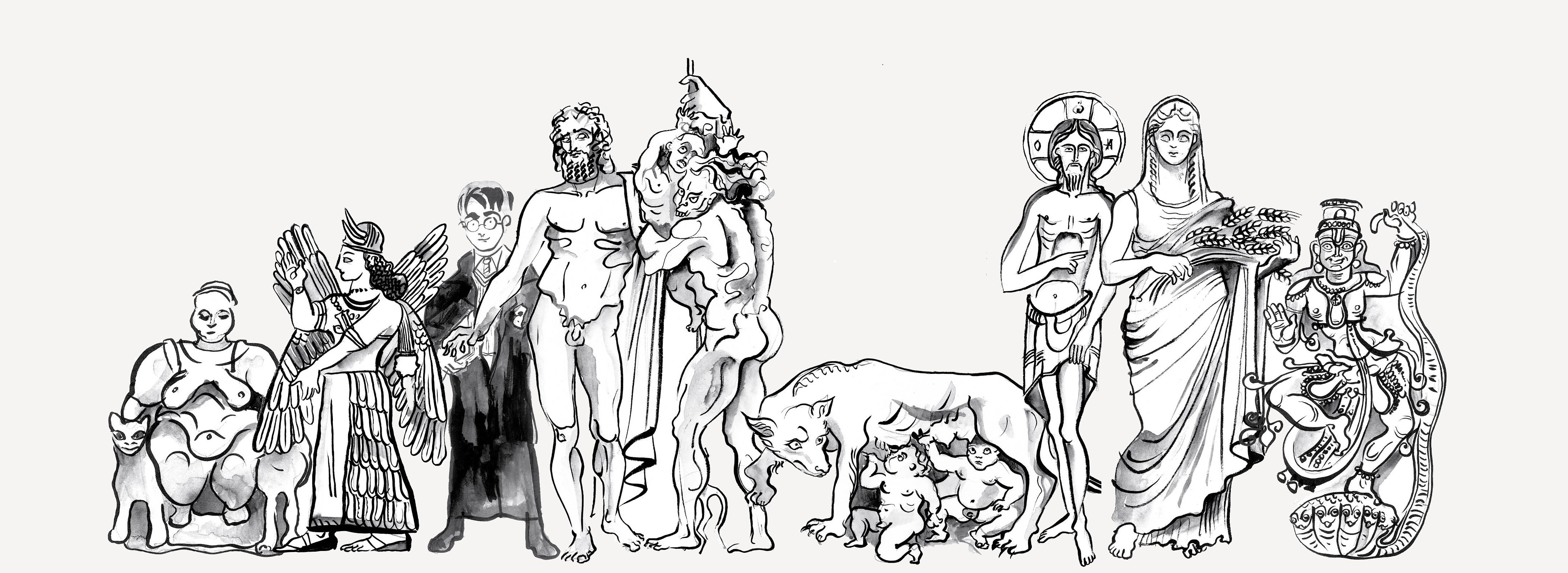
“Critics make a distinction between the Jesus of history – the man who walks the Galilean hills – and the Jesus of faith, who is, as you say, sort of a mythical legendary figure. And I think the difficulty is in separating the two,” says theologian and historian Helen K. Bond as she talks to Tomasz Stawiszyński about the myths and realities around Christianity’s most important prophet.
Tomasz Stawiszyński: Did Jesus really exist?
Helen K. Bond: Yes, I think so. There’s some very good evidence that he existed, actually more than with Alexander the Great or many other famous figures from the ancient world. And you have to remember that he’s a provincial figure: he’s not of the elite, he’s not the kind of person you would expect much literature to be written about, and yet, within twenty years after his death, we have Paul’s letters. Paul knows people who knew Jesus, that’s really clear from the letters. I think that’s a pretty good basis for believing that Jesus did exist.
Saint Paul’s letters are the foundation of Christianity. In what sense and to what extent can we interpret them as historical documents?
There are other historical sources. Undoubtedly, the best evidence comes from outsiders or opponents. Josephus mentions Jesus in his Antiquities of the Jews, and that’s written around 100 AD. There’s a paragraph about Jesus, although the difficulty is that people think that it’s been tampered with by Christians – the general scholarly view at the moment is that Christians have added certain bits and maybe taken something away. Still, there is also a bit about Jesus in another part of the Antiquities, where Josephus talks about his brother, James, and also we get references to Jesus in other Roman texts, but they’re all second century. Roman writers generally aren’t very interested in Jesus. He’s a provincial, he’s the founder of some kind of strange superstition, so they’re far too elite to be interested. Once Christianity becomes a movement, once it comes onto their radar and they’re having to deal with it in some way, then they get interested. So, for example, Tacitus talks about Jesus when he’s telling his readers about Nero’s persecutions in Rome: he says Nero persecuted the Christians, and that’s where you get a little reference to Jesus, who, we learn, is the founder of the movement and was crucified by Pilate. You have hostile writers, Roman writers, Jewish writers and Christian texts that go a long way back. Though Paul’s letters are clearly religious, they are also, I think, historical documents. All those references to Peter and other disciples, they don’t give the impression that Paul is just completely making this all up twenty years after the fact.
Jesus is the most powerful mythical hero of the Western culture. How do we distinguish between myth and facts? Is that even possible?
That’s really difficult. Critics make a distinction between the Jesus of history – the man who walks the Galilean hills – and the Jesus of faith, who is, as you say, sort of a mythical legendary figure. And I think the difficulty is in separating the two. I’m trying to work out what the actual man stood for and then, after the resurrection when everything changed, how did the religion, which was founded in his name, develop.
When you talk about the resurrection, you mean a certain mythical idea, not a historical fact, right? In a sense this is also a question about your personal view on Jesus, although from the scientific viewpoint the resurrection is obviously a myth.
As a historian, you can only say that the first Christians had some kind of very powerful idea that Jesus, who had died on a Roman cross, was brought back to life; that he somehow lived again. The language they used to describe that is resurrection. There’s a whole debate about what does that mean. Were there actually two men? Maybe some people had visions? Was it a mixture of both? How exactly did these things happen? And, as you say, much depends on your own position about Jesus and also your own position about what kinds of things can happen in the world – how much scope you give for the miraculous, and so on. But I think as a purely historical fact, something must have happened to create this sense that his death was not the end of the message, that this is not a failed messiah, that there’s more to say.
Christianity puts great emphasis on the actual historical existence of Jesus. Saint Paul says: if there was no resurrection, our faith is hollow. Therefore, a historian who studies Jesus while being a Christian herself finds herself in a sort of conflict of interests, doesn’t she?
The whole thing about being an objective historian is that you try as much as possible to put your own views to one side. Of course, this is an area where people are very unlikely to be able to do that. Christian historians who work on the historical Jesus are, not surprisingly, far more ready to claim that we can prove that the tomb was empty. I suppose I’m a little bit agnostic on that. As a historian, I cannot say anything about whether Jesus exploded the scientific universe as we know it. But I can say that there was this huge feeling that something had happened to Jesus; that he had been raised by God. Whether it had happened or not, there was clearly enough there to turn the believers into missionaries.
Who, then, was Jesus and what were his teachings?
The thing to do is to look at the gospels, especially Mark’s. It is usually thought to be the first one, written around 70 AD. Of course, the difficulty with all the gospels is that they reflect the post-resurrection faith. They are depictions of Jesus made after forty years of thinking about the resurrection. But I think some things are believable. For example, Jesus seems to have been a Jewish prophet. He’s announcing the kingdom of God. The number of his male disciples seems to be important: it clearly represents the twelve tribes of Israel, and therefore it seems to me that Jesus wants to restore Israel, to restore the Jewish faith, to bring people back to a closer relationship with God. So I think he’s very much a prophet within a Jewish framework.
Géza Vermes, one of the most distinguished historians dealing with Jesus, claims that he was a Jewish teacher, completely inside a paradigm of Judaism, and that Christianity – especially the gospels – are essentially the works of competing factions among his disciples. According to this view, Jesus certainly wasn’t the first Christian.
Yes, of course. I completely agree. Christians are wrong when they see him as the first Christian. He was a Jew within the Jewish faith, teaching a Jewish renewal. For the first few decades after his death, his followers were also Jews. And he wasn’t unique, either. There were lots of holy men claiming certain things – John the Baptist is the most well-known. I think Jesus was very much a Jewish creature and went to his death as a Jewish creature with a following that was drawn from Jews. It was only afterwards – and I think this is the contribution of Paul – when the message starts to go beyond the Jewish world. Paul wasn’t the first: other people had started to bring gentiles in before. But the great thing that Paul does is to say: actually, if you want to follow Jesus, you can just follow Jesus and you don’t have to follow Jewish law. And so Paul really works at this theological underpinning for the Christian faith. That’s really what allows it to become a universal religion.
So how much Jesus is there in Jesus? How much of his actual life and teachings survived in the contemporary Christian message?
Well, Paul actually doesn’t say very much about the historical Jesus at all. The important things for him are the cross, the resurrection, and what God has done through the resurrection. It’s only really later, with Mark’s gospel, that the Christians begin to consider Jesus’s life as important. They want to have a biography of Jesus, for it is the model of a Christian life. As for its accuracy, I wouldn’t want to put a percentage on it, because that’s far too scientific and clinical. I think one of the things about biographies is that they tell stories about people. And stories can be true even if the actual details are not. A lot of the sayings in gospels probably go back to Jesus. His interest in the poor, the marginalized, his teachings about don’t try to be the first, put yourself last, deny yourself – I think in a general sense that does go back to Jesus. But those aren’t his precise words. The gospels were written in Greek, while Jesus would have spoken Aramaic. So we’re talking here about forty years of passing on stories, translating them into different languages; into different cultures. I think the important thing is that the gospels preserve the gist of what Jesus is saying.
Historians, however, question the responsibility of Jews for his death.
I agree with that. I think the difficulty is that Christianity started as a part of Judaism. Gradually, over a long period of time, it separated. Bringing the message to the gentiles was one thing that would have caused the divisions. When the Temple in Jerusalem fell in 70 AD, that also caused everybody to think about identity. Who am I? What does it mean to be a Jew? What does it mean to be a Christian? There was a great deal of hostility between the synagogue and the emerging Christian Church. I think that hostility is reflected particularly in the gospel according to Matthew, who is very, very negative towards the Pharisees. As is John. They are likely reflecting the hostility that Christian groups had experienced, and probably there was hostility on both sides. Within all of that, there’s a lot of attention to putting the death of Jesus on the Jews and also exonerating Rome, because obviously at this time most of the new converts to Christianity were going to be Romans. When they would hear about Jesus’ crucifixion, about a hideous execution by a Roman governor, they would start to think that he must have been a rebel against Rome. Therefore, the whole strategy in the Passion narratives is to say that Pilate didn’t really want to kill Jesus – it was only those bad Jewish leaders who bullied him into it. That’s a deliberate kind of political rhetorical technique to try and make things okay for the new gentile converts.
So how did it happen that the Christianity became the world’s biggest religion? What is the secret of its enormous popularity?
In the first century AD, many people, particularly in the pagan world, were looking for a more individual religion or an individual link with a particular God – you have mystery religions, the cults of Isis or Mithras, things like that, becoming quite popular at this time. Even Judaism becomes popular, although a lot of people want to stay on the fringes; they don’t want to get circumcised and to keep the law. I think this idea of having one God and a personal religion was very attractive to a lot of people. Also, Christianity was really aiming its message not at the elite, but at ordinary people, and I think that was an important aspect. I would say that Christianity was very countercultural in its day. It wasn’t just about ‘love everybody, and you’ll be fine’ – it was really challenging the whole system, it was saying that what the Roman world thinks of as honourable is not honourable at all. The message was: you guys, the lowly people, you are the ones who are in your own way honourable. You are going to inherit the Earth. And it is people like you who God is interested in and is taking care of.
However, at some point in the fourth century during the reigns of Constantine and Theodosius, Christianity becomes an official religion of the Empire. The Polish theologian and historian Stanisław Obirek claims that it was a watershed moment, because all the countercultural radicalism of Christianity ended there and then, and Christianity became the exact opposite of what it was at the beginning.
Yes, maybe not the absolute opposite, but clearly things changed once it became the religion of the elite. Once Constantine converted, there were all sorts of reasons why other people would want to become Christian as well. You have all these councils, and there’s this standardization as well. Prior to that, there were many kinds of different ways of being a Christian; there wasn’t a creed, people had different texts, there were various ways of living out your Christian life. But things start to become standardized, in a way that suits the ruling elite, and quite a lot is changing. Probably ordinary people are still living out their Christianity as they always have done, but the institutionalization is now under way.
Do you think that studying the historical Jesus can influence modern Christianity in a meaningful way?
Well, I think probably the Catholic position would be that we had a subsequent revelation about Jesus, so it’s all very well to find out about the historical figure, but that wasn’t the full story, because then we have the resurrection, then we have creeds and councils, all directed by God. If you’re buying a phone, you don’t go back to the original model – you buy the latest model because that’s the best one. I think it’s more of a Protestant idea to want to go back to the beginning, and so perhaps within Protestant churches people are more interested in saying: well, what’s the real heart of the message of Jesus? The problem is that it’s not easy to find out. There are different views about what the historical Jesus said depending on different scholars. But I do think actually that historical Jesus scholarship is something that is useful to the Church today, because my sense is that a lot of people don’t like organized religion and they think it has gone astray, it has led to violence, it has led to wars. All of the latest scandals in the Catholic Church about priests and small boys didn’t help. But at the same time, a lot of people say: well, I like Jesus. I like what he stood for. He’s got some good ethics, good morals. There’s something still quite modern about his message, even actually his idea that the end of the world is coming. Fifty years ago, that didn’t sound very modern. But now with climate change, he can be a spokesperson for the kids who are on climate strikes. There’s a lot in the figure of the historical Jesus that can speak to people today, and I think the church might do well to try and reclaim some of that.
What else in Jesus’s teachings do you find important?
For me personally, I do think Jesus has a lot still to say to the modern world, particularly about not being too self-important, putting yourself last and trying to turn the other cheek, not to take up arms, not to be violent. I think those are good messages for today.
Parts of this interview have been edited and condensed for clarity and brevity.
Helen K. Bond:
An English historian and theologian specializing in early Christianity, Head of the School of Divinity, University of Edinburgh, author of The Historical Jesus: A Guide for the Perplexed (2012) and Jesus: A Very Brief History (2018).
Introduction and biography translated by Jan Dzierzgowski








